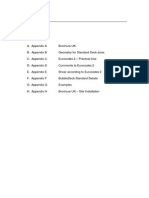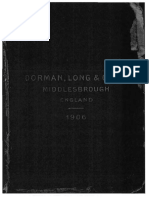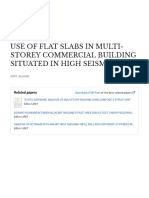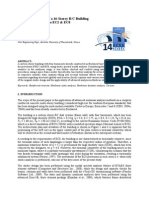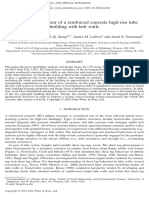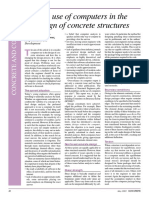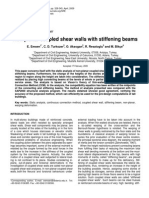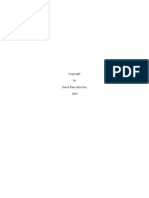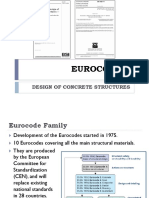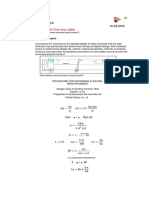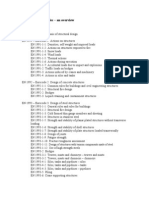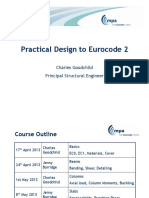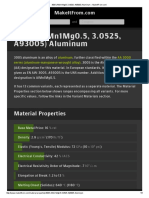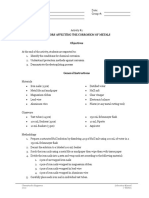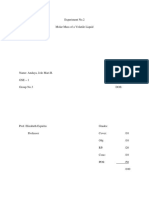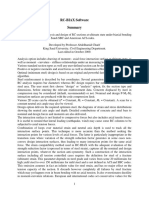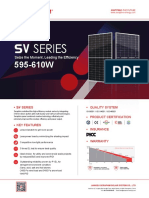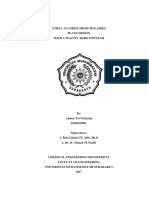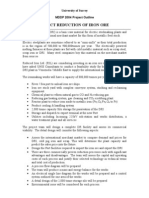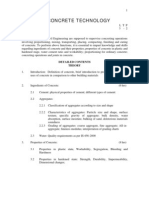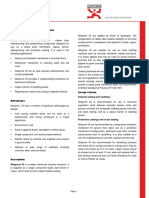CSE49400 Advanced Structural Design
C1: Introduction to Eurocodes
�Overview
Outline
General Introduction
Introduction to EN 1990 & EN 1991
Composite Beam
Shear Connection
Composite Slab
Composite Column
�Historical Development
Historical development of Eurocodes:
Idea of Eurocodes dates back to 1974
- Ref: Eurocodes, 19702010: why 40 years?, Emeritus
Professor Roger Johnson, ICE (Structures and Buildings)
Family of design codes
Harmonisation of treatment
Removal of barriers to trade
Framework for development
3
�Scope of Eurocodes
Scope of structural Eurocodes:
A total of 10 codes (comprising 58
documents versus 57 British Standards
documents)
The first 2 codes are material independent:
EN 1990 Basis of structural design
EN 1991 Actions on structures
�Scope of Eurocodes
Remaining 8 codes focus on materials:
EN 1992 Design of concrete structures (4 parts)
EN 1993 Design of steel structures (20 parts)
EN 1994 Design of composite structures (3 parts)
EN 1995 Design of timber structures
EN 1996 Design of masonry structures
EN 1997 Geotechnical design
EN 1998 Design of structures for earthquakes
EN 1999 Design of aluminium structures
5
�Timetable for introduction
Codes published by CEN
Comit Europen de Normalisation
European Committee for
Standardisation
National standards bodies adopt (BSI)
Two years to produce National Annex
Three year co-existance period
Conflicting existing standards withdrawn
http://shop.bsigroup.com/Browse-BySubject/Eurocodes/Publication-schedule/
�Eurocode 4 Part 1-1
�Eurocodes
Codes will be published by CEN in 3
languages:
English
French
German
All codes originally developed in English, and
then exactly translated
Other participating counties will either use 1 of
3 language versions available, or translate at
own cost.
8
�EN 1990 (2002)
EN 1990 Basis of structural design
UK National Annex published
Should read at least once.
EN 1990 states that a structure shall have
adequate:
Structural resistance
Serviceability
Durability
Fire resistance
Robustness
�Design situations
All relevant design situations must be
examined:
Persistent design situations: normal use
Transient design situations: temporary
conditions, e.g. during construction or repair
Accidental design situations: exceptional
conditions such as fire, explosion or impact
Seismic design situations: where the
structure is subjected to seismic events.
10
�Actions and Effects
Action (F):
CAUSE
Direct actions applied loads
Indirect actions imposed deformations or
accelerations e.g. by temperature changes, vibrations
etc
Both essentially produce same effect
Effect of action (E):
EFFECT
On structural members and whole structure
For example internal forces and moments,
deflections ..
11
�Types of actions and Load combinations
Types of actions:
Permanent, G
Variable, Q (leading and non-leading)
Accidental, A
Fundamental combinations of actions may be
determined from EN 1990 using either of:
Equation 6.10
Less favourable of Equation 6.10a and 6.10b
12
�Load combinations
1.5 x combination factor x Other
variable actions
Equation 6.10:
to be combined with
Actions due to
prestressing
G "+" P "+" Q "+" Q
G, j
k,j
Q ,1
k ,1
j 1
1.35 x Permanent actions
Q ,i
0 ,i
k ,i
i>1
1.5 x Leading
variable action
Load factors 1.35 and 1.5 are applied when actions are
unfavourable.
13
�Leading variable actions Qk,1
In Equation 6.10, the full value of the leading variable
action is applied Q,1Qk,1 (i.e. 1.5 x characteristic
imposed load)
The leading variable action is the one that leads to the
most unfavourable effect (i.e. the critical combination)
E.g. Wind: Brace versus Gravity: Beam & Column
To generate the various load combinations, each
variable action should be considered in turn as the
leading one, (and consideration should be given to
whether loading is favourable or unfavourable.)
14
�Combination factor 0
The combination factor 0 is intended specifically to
take account of the reduced probability of the
simultaneous occurrence of two or more variable
actions.
Loading
Combination
factor 0
Imposed loading
0.7
Wind loading
0.5*
* 0.5 is UK NA value, 0.6 is the unmodified EC value
15
�Unfavourable and favourable loading
Loads may be considered as unfavourable or
favourable in any given combination, depending on
whether they increase or reduce the effects (bending
moments, axial forces etc) in the structural members.
For unfavourable dead loads: G = 1.35
For favourable dead loads: G = 1.00
For unfavourable variable loads: Q = 1.5
For favourable variable loads: Q = 0
E.g. Truss: Gravity vs Wind (Uplift)
16
�Equivalent horizontal forces
Equivalent horizontal forces:
Equivalent horizontal forces (EHFs), previously known
as notional horizontal loads (NHL) in British standard,
are required to account for imperfections that exist in
all structural frames.
EHFs should be included in all load combinations, and
since their value is related to the level of vertical
loading, they will generally be different for each load
combination (and will already be factored).
17
�Exercise solution Equation 6.10
Load combinations for a typical structure from
Equation 6.10:
Combination
Dead
Dead + Imposed
1.35
Dead + Wind (uplift)
1.0
D+I+W
(imposed leading)
1.35
D+I+W
(wind leading)
1.35
Imposed
Wind
EHF
1.0
1.5
1.5
1.0
1.5
0.75
1.0
1.05
1.5
1.0
Note EHF are always present and already based on factored loads
18
�Load combinations
Equations 6.10a and 6.10b use less
favourable result:
G, jGk , j " " PP " " Q ,1 0,1Q k ,1 " " Q ,i 0,iQ k ,i
j1
i1
j G, jGk , j " " PP " " Q ,1Q k ,1 " " Q ,i 0,iQ k ,i
j1
i 1
Unfavourable dead load reduction
factor (i.e. not applied when G = 1)
= 0.925 in UK NA
(0.85 is the unmodified EC value)
19
�Exercise solution Eqs 6.10a and 6.10b
Load combinations from Eqs 6.10a and 6.10b All
combinations except last one are from Eq. 6.10b.
Combination
Dead
Dead + Imposed
(6.10b)
1.25
Dead + Wind (uplift)
(6.10b)
1.0
D + I + W (6.10b)
(imposed leading)
1.25
D + I + W (6.10b)
(wind leading)
D + I + W (6.10a)*
Imposed
Wind
EHF
1.0
1.5
1.5
1.0
1.5
0.75
1.0
1.25
1.05
1.5
1.0
1.35
1.05
0.75
1.0
* Unlikely to govern unless Dead >> Imposed
20
�Equilibrium check (EQU)
Equilibrium check (EQU):
For checking sliding or overturning of the
structure as a rigid body, only Eq. 6.10 may be
used. Dead loads are factored by 0.9 when
favourable and 1.1 when unfavourable.
The critical case will generally arise when wind
load is unfavourable and the leading variable
action, and dead load is favourable, resulting in:
0.9Gk + 1.5Wk + EHF
21
�Equilibrium check (EQU)
Favourable and unfavourable loading:
Wind load unfavourable,
dead load favourable,
imposed load favourable
1.5 Wk
0.9 Gk
Overturning point
Wind load unfavourable, part
of dead load favourable, part
unfavourable, part of imposed
unfavourable
1.5 Wk
0.9 Gk
1.1 Gk
+ 1.05
Qk
Overturning point
22
�Parts of EN 1991
EN 1991 contains the following parts:
EN 1991-1: General actions
EN 1991-2: Traffic loads on bridges
EN 1991-3: Actions from cranes and machinery
EN 1991-4: Actions in silos and tanks
23
�Sub-parts of EN 1991-1
EN 1991-1 contains the following sub-parts:
EN 1991-1-1: Densities, self-weight, imposed loads
EN 1991-1-2: Fire
EN 1991-1-3: Snow loads
EN 1991-1-4: Wind actions
EN 1991-1-5: Thermal actions
EN 1991-1-6: Actions during execution
EN 1991-1-7: Impact and explosions
24
~~ The End ~~


















